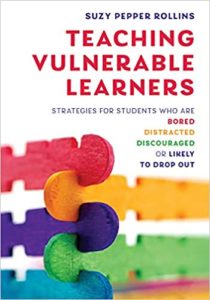Our Vulnerable Learners Need Our Best Supports
 By Suzy Pepper Rollins
By Suzy Pepper Rollins
Learning can be risky business.
Students are called upon throughout the school day to jump in willingly on a new math concept, to interpret a science experiment, or to defend a position in social studies. At every turn, failure and even embarrassment are potential outcomes.
Students’ brains scan the learning expectations to ascertain the risk level and determine if the reward is worth the potential negative outcomes.
Learners with successful academic track records understandably jump in more readily. Their hands often shoot confidently in the air. Their answers are almost always correct, and if not, they rebound quickly, determined to right the course. Not only do they not mind getting papers back, they are often the ones asking, “Can we take a grade on this?”
These students are in the success loop: Positive feedback from teachers, peers, and parents further propel their momentum, and they continue to expend a high level of effort. Recognition of their efforts is obviously warranted.
The ideas below, however, include targeted strategies to move our more vulnerable students into the success loop right next to more successful learners.
It takes courage to be a learner who is behind in school.
In fact, it is commendable that they continue getting on the bus in the morning…or even log in for distance learning.
A student who has experienced a lot of academic failure is like an employee who is terrible at their job but forced to engage in it for seven hours straight anyway. These learners often find ways to hide, disappear, and disengage. Or they might act out in sheer frustration or shame. They often dread having graded work returned and may toss it immediately in the trash…or tear it to smithereens.

Every child wants to be successful, but for these students school has become a tough, perhaps even hurtful, place. To pull them into the success loop first requires an understanding of their plight, even if some of their failures are somewhat self-induced. Beyond understanding, however, is a willingness to continue supporting them with targeted strategies that work.
First, let’s clear the table of strategies that don’t typically work well.
Providing students who are barely hanging on academically with tedious, overly structured work will provide predictably negative results, including increased demotivation, ramped up frustration, and further academic slide.
Unfortunately, this is what they are often provided – including seemingly endless computer screens. Often included in these attempts are wholesale remediation plans that include a laundry list of gaps these students have incurred over the years.
Unfortunately, these skills might not be applicable to learning today’s new tasks, so students might not realize success today in class, right when they need it. Teaching skills out of context, rather than applying them to what we’re learning right now, decreases the likelihood of them “sticking” this time around any more effectively.
Lastly, remove grade level retention as an option. This approach has been researched for almost a century with resounding evidence that it not only does not work, but often makes things worse.
What does work with academically vulnerable learners?
Here are some proactive, targeted strategies that can move learners into the success loop with their peers:
► Scaffold just the prerequisite gaps where students will be needing support to address this week’s learning targets – not everything they might have missed. For example, if students will be using integers, create bookmarks with integer rules. Similarly, language arts students might benefit from devices with capitalization rules or figurative language explanations. In science, create math scaffolding for just in time remediation.
► Consider introducing vocabulary, prerequisite skills, and critical prior knowledge with targeted students before the concept is taught in the whole group setting. By embedding prior knowledge, students can more readily latch on to new learning, comprehend text at a higher level, and participate more actively in class. Even fifteen minutes of a mini-lesson preview on moon phases or decimals can provide just enough prior knowledge to boost self-efficacy in class.
► Craft high interest, personally relevant tasks. Perceived value in a task is one of the cornerstones of student motivation. In addition, incorporate distinct jobs within groups that provide leadership opportunities.
► Encourage all students to participate in extra-curricular activities. This enables students to shine in areas other than academics and to develop relationships with educators outside of content areas.
► Include choices in tasks, readings, and classroom learning situations. Choices provide a sense of autonomy over one’s academic future, especially for the academically vulnerable. Choice boards, multiple writing prompts, and selecting ten math problems out of fifteen provide opportunities for autonomy.
► Open class with something captivating that promotes thinking and discussion. Success in the opening minutes can provide opportunities for positive feedback, which promotes a sense of good will with students. Avoid graded activities in the opening minutes or bland warm-ups.
► Create short, diverse learning segments, such as with station teaching. Rather than a long stretch, stations provide ten minutes of interesting work that better mirror attention span. In addition, include answer keys at each station so that students receive feedback. Design stations so that students get up and move.
In addition to a toolkit of instructional strategies, improve the lives of vulnerable learners with positive relationships. Welcome them to class every day. Visit with them about nonacademic interests they have, from movies to sports. Search for strengths on which to build. If they are returning from an absence (or suspension), let them know they were missed. Seek opportunities for leadership.
Virtual school presents extra challenges for vulnerable learners.

After students become embedded in a failure cycle, a sense of futility may emerge. Their behaviors may not look like vulnerability. They might disengage completely, accumulate absences, or act out in class. The shift to virtual learning increases our concerns for these vulnerable learners.
Gaps may be widening, since self-paced, independent learning is often not their strength. Many have weaker reading or math skills, so teaching content to themselves at home is often not a viable strategy. Some may not even be logging in every day. And, given their vulnerability, the opportunities for building positive relationships is vastly diminished.
It will take courage for them to return to school. We must also muster our courage to find ways reach out to them, however we can, to create academic success. Because school, for these learners in particular, is indeed risky business.
 Suzy Pepper Rollins is the author of the new book, Teaching Vulnerable Learners (WW Norton), reviewed here by Laura Von Staden. She is also the founder of Math in the Fast Lane, a national consultant/speaker, and can be reached at SuzyPepperRollins.com.
Suzy Pepper Rollins is the author of the new book, Teaching Vulnerable Learners (WW Norton), reviewed here by Laura Von Staden. She is also the founder of Math in the Fast Lane, a national consultant/speaker, and can be reached at SuzyPepperRollins.com.
Suzy was the Remedial Education Coordinator for Cobb County (GA) Schools in metro Atlanta from 2000-2011 and is also the author of two books from ASCD, Teaching in the Fast Lane and Learning in the Fast Lane.

































